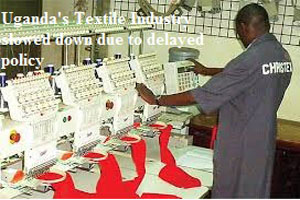
Uganda's Textile Industry slowed down due to delayed policy
YarnsandFibers News Bureau 2016-03-13 15:00:00 – AfricaA decade ago, Uganda produced 254,000 bales of cotton annually, each weighing 185kg. About 10 percent of Uganda's annual cotton output is processed locally and 90 percent of its cotton as lint (primary form) is exported as value addition continues to elude the industry due to the delayed National Textile Policy. The country has more than 38 cotton lint exporters with some ginning.
The policy was formulated in 2009, debated and passed, but it is yet to be implemented. The efforts to revive textile industry have slowed down leading to the loss of about Ush500 billion ($149.4 million) annually, in the form of exports of unprocessed cotton.
Samuel Ssenkungu, director in charge of the department of Trade, Industry and Co-operatives at the Ministry of Trade, said that the lack of funds is hindering the policy's implementation.
The biggest challenge is transferring the policy recommendations to respective ministries during the budgetary formulation process. The policy, for example, requires all government primary schools to buy uniforms produced in the country. But this has not happened, added Mr Ssenkungu.
The lack of value addition means the country earns far less revenue than it would otherwise get. Whereas a kilogramme of exported cotton fetches approximately $1, a twofold piece of cloth made from the same quantity of lint can fetch at least $8. This is in addition to other benefits from the industry such as job creation.
Consequently, whereas Uganda earned $46.9 million from the 254,000 bales of cotton produced annually a decade ago, the same cotton would generate about $375. 9 million today, exported in processed form.
The National Textile Policy notes that with an East African population of 120 million people, the region has a market potential for 820 million metres of cloth per annum, generating about Ush1.4 trillion ($415 million).
Uganda's cotton farmers also have a market potential of 400 million people in the Common Market for Eastern and Southern Africa (Comesa) which the country is part of.
Comesa requires some 2.4 billion metres of clothes per annum, at an average per capita consumption of six metres.
Other trading regimes that Uganda is part of are the East African Customs Union, the Economic Partnership Agreement (EPA) with the European Union, the Africa Growth and Opportunity Act (Agoa), and the Everything-but-Arms (EBA) initiative which guarantee broad market access.
Such market sizes would be significant in attracting investors.
Agoa and EPA duty- and quota-free access to the US and the EU has been constrained by Uganda's inability to produce internationally acceptable standards of fabric.
Market Intelligence
Ask for free sample Report

experience
Customer Base
dedicated team
Countries Served Worldwide









